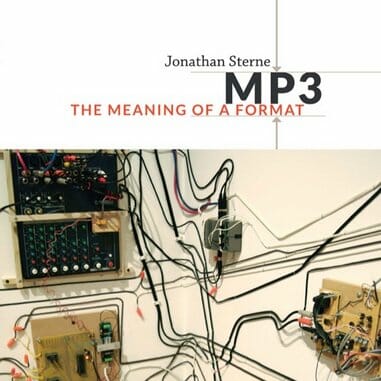MP3: The Meaning Of A Format by Jonathan Sterne
From cats to MP3s

Early in MP3: The Meaning Of A Format, the author Jonathan Sterne describes an important—and surprisingly grisly—experiment in the history of audio technology.
The psychologists Ernest Wever and Charles Bray “removed part of a cat’s skull and most of its brain in order to attach an electrode. . . to the animal’s right auditory nerve. . . electrodes were then hooked up to a vacuum tube amplifier,” and “signals were sent to a telephone receiver.”
Wever and Bray may have hoped to create some sort of four-legged Frankenstein, but instead they found that when someone made noise near the cat’s ear, the sound transmitted clearly to the telephone receiver. After testing all “other possible explanations for the transmission of sound down the wire,” the scientists killed the cat. The wire’s ability to transmit sound faded and then stopped.
The reader might wonder what an inhumane experiment from 1930 could possibly have to do with the MP3, a thoroughly modern technology. Well, this tale of an unlucky cat serves to illustrate one of Sterne’s most important points: “… encoded in every MP3 are . . . whole histories of sonic practices. . . Digital media encapsulate ‘an accumulation of the auditive technologies of the past.’”
Sterne, an academic at McGill University, envisions MP3 as more than just a history of the MP3 technology (although it is that). He writes a cultural study with a specific purpose: “… to redescribe context, to analyze conjunctures, to attend to the relations of people, power and practices built into any phenomenon or problem.”
In English? He roots a recent development, often seen as an unprecedented product of the digital age, in a long history of several fields.
The MP3 represents only one of three possible encoding methods standardized for digital audio by the Moving Pictures Experts Group in 1992. These three methods emerged as favorites after a series of tests involving “expert listeners” picked from a specific pool of people. Much like our political representatives, the group that decided the future of listening skewed heavily towards the male, the old and the white.
These worthies listened to certain kinds of sounds picked by engineers—Billy Joel, Led Zeppelin, Suzanne Vega, Tracy Chapman—in compressed and uncompressed formats. Instructed to listen “for form, not content,” they attempted to ignore the music itself and “listen for sonic artifacts of the technical process.” Of the different standards, the MP3 ended up becoming common.
Why? Because a hacker got hold of the code behind the process and put it out for free.
For those who don’t know, MP3s are those little digital files, often found whirling around the Internet—“the most common form in which recorded sound is available today,” writes Sterne. In fact, “… more recordings exist and circulate in MP3 format than in all other audio formats combined.” MP3s are compressed versions of bigger files, missing “the parts of the audio signal that are unlikely to be audible,” and reorganized to get rid of “repetitive and redundant data in the recording.” According to Sterne, an MP3 can end up “as small as 12 percent of the original file size.”
MP3s may contain reduced amounts of information, but Sterne’s book about them is very dense. Admirably interdisciplinary, it pulls from history, the science and engineering of acoustics, politics, economics, psychology and philosophy, incorporating both interviews and diagrams. Prominent thinkers (dead and living) of all ages and persuasions make appearances. As an academic, Sterne takes advantage of one of his profession’s primary perks—coining terms, like “mediality” and “perceptual technics.”
To simplify Sterne’s story greatly—to MP3 it, if you will—experiments like Wever and Bray’s led scientists and engineers to think about ears and phones interchangeably. This approach to research aligned with the bottom-line-driven desires of phone companies. The telcos wanted to squeeze the maximum amount of signals into telephone lines (we’re talking landlines here, real “auditive technologies of the past”) without losing information. Work to this effect led to the development of “lossless compression.” This allowed “eliminating redundant data in a transmission with no measurable change to the output.”
“Perceptual coding,” the next important development, relied on techniques known as auditory and temporal masking.
-

-

-

-

-

-

-

-

-

-

-

-

-

-

-

-

-

-

-

-

-

-

-

-

-

-

-

-

-

-

-

-

-

-

-

-

-

-

-

-








































